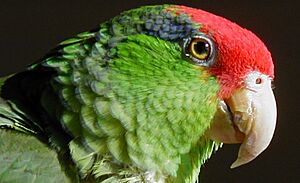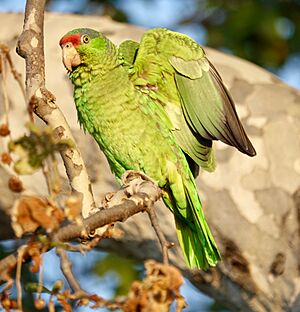Red-crowned amazon facts for kids
Quick facts for kids Red-crowned amazon |
|
|---|---|
 |
|
| Conservation status | |
| Scientific classification | |
| Genus: |
Amazona
|
| Species: |
viridigenalis
|
 |
|
The red-crowned amazon (Amazona viridigenalis) is a colorful parrot. People also call it the red-crowned parrot or Mexican red-headed parrot. These birds are native to northeastern Mexico and possibly southern Texas in the United States.
Sadly, the red-crowned amazon is an endangered species. This means there are not many left in the wild. Experts believe there are only about 2,000 to 4,300 adult birds remaining. The biggest dangers to these parrots are people illegally catching them for the pet trade and the loss of their forest homes in Mexico.
Contents
What Does the Red-crowned Amazon Look Like?
Red-crowned amazons are mostly green. Their most special features are a bright red forehead and the top of their head. They also have a dark blue stripe behind their eyes and light green cheeks. Sometimes, you might see splashes of red and blue under their wings. Their tail feathers often have light yellow tips.
These parrots have a white ring around their eyes, which makes their eyes stand out. Their eye color can be bright yellow or deep red. However, young parrots have gray eyes until they grow up. Their beaks are usually a horn color, but can sometimes have black parts. Their legs are beige or gray.
Red-crowned amazons are about 28 to 33 cm (11 to 13 in) long from their beak to the tip of their tail. Their wings can spread about 38 to 41 cm (15 to 16 in) wide. They usually weigh around 270 g. It's hard to tell male and female parrots apart just by looking at them. The only sure way is through genetic testing.
Where Do Red-crowned Amazons Live?
These parrots naturally live in the lowlands of northeastern Mexico. They might also live in the very southern part of Texas. Red-crowned amazons do not migrate long distances. They stay in their native areas but might move around to find food.
Some red-crowned amazons have become feral (wild populations that started from escaped pets) in cities. You can find them in places like southern California, southern Florida, and the island of Oahu in Hawaii.
In 2019, the United States Fish and Wildlife Service said that red-crowned parrots are native to Texas in the Rio Grande Valley. However, parrots are not covered by a special law called the Migratory Bird Treaty Act. This means parrots in Texas rely on state and local laws for protection. In 2019, there were about 700 wild red-crowned parrots in the Rio Grande Valley of Texas. Some records show parrots in South Texas as early as 1885. The number of wild parrots in the United States is now similar to populations in Mexico. This is because they have learned to live in cities. However, some groups still consider the bird non-native to all parts of the United States.
Feral Parrots in Cities
Many feral parrots live in cities, especially in the Los Angeles metropolitan area in California. This started around the 1960s when captured birds escaped and began living in the wild. The California Parrot Project says that red-crowned amazons are one of thirteen parrot species that now live wild in California.
Los Angeles has become a safe place for this endangered species. There are about 3,000 red-crowned amazons living there. This number might even be more than the wild population left in Mexico. People who live in these areas say the birds can be noisy. But they also bring a sense of pride and identity to the local community.
How Do Red-crowned Amazons Behave?
Red-crowned amazons often gather in large groups. They are usually loudest in the morning and evening. You can often hear their loud screeches when a big group flies to a new place to eat.
Their diet includes seeds, fruits, flowers, and nectar. Like most parrots, red-crowned amazons make their nests in holes in trees.
It's quite easy to understand how amazons are feeling by watching their eyes. Red-crowned amazons will pin their eyes when they are excited. This means their pupils quickly get bigger and smaller. You can easily see this against their bright eye color. This eye pinning, along with other body language, helps other parrots or their owners know what they are feeling. For example, an angry parrot might fan its tail feathers. A happy parrot might purr or bend its head down to be scratched.
Red-crowned Amazon Life Cycle and Reproduction
Red-crowned amazon parrots are ready to have babies when they are about five years old. The female parrot sits on her eggs for about 28 days. She usually lays about four eggs at a time. The young birds start to fly (fledge) when they are about nine weeks old.
In the wild, these parrots usually mate for life. They find tree holes near other parrots in their group, forming a breeding colony. They will often return to the same tree hole each year to raise their chicks. They only change if the hole was disturbed or if they didn't have success raising babies there before.
Red-crowned Amazons as Pets
These parrots are often kept as pets. They can be very loving and playful if their owners give them enough attention. Some red-crowned amazons are excellent at copying human voices. But they are best at mimicking sounds they hear often, like a microwave, a telephone, or other pets. Many owners say these parrots can be a bit mischievous because they are very curious.
Red-crowned amazons can live for more than 50 years as pets. Some have even lived over 70 years if they are cared for well.
Owning this type of parrot can have some challenges. It's important to give them enough exercise. It can also be tricky to get them to eat a healthy and varied diet, similar to what they would eat in the wild. Amazons can become lazy if they don't have enough things to do. This can lead to health problems like being overweight.
These birds are generally quite strong and not overly sensitive. They handle stress better than some other pet parrot species. Problems like feather plucking (pulling out their own feathers) due to stress are not common for them. Another challenge for some owners is "hormonal bluffing" during the spring breeding season. This can make some parrots, especially males, more likely to nip or bite people who are not their favorite person. They might also scream more. These hormonal behaviors usually decrease as the parrot gets older.




